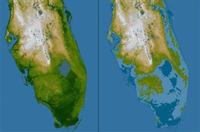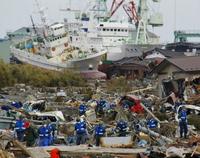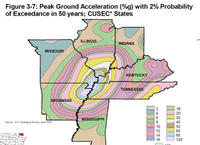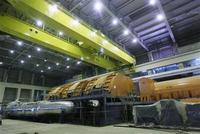-
Portable military barriers help Canadian city in flood fight
Canada is using a new technology to prevent flood damage in Manitoba; the one-meter-square wire cages can be unfolded and quickly filled with dirt or mud; they can also be linked for a long row that can be set up far quicker than it takes to sling sandbags; the barriers have been used by the U.S. military to protect embassies from terrorist attacks, and have also been used for flood protection in the United States
-
-
Huawei tries to crack U.S. market again with U.S. Cellular deal
Chinese giant Huawei Technologies Co. recently announced that it was the finalist for a contract to build a fourth generation wireless network for U.S. Cellular Corp, the nation’s sixth largest wireless carrier; in response to the deal, U.S. lawmakers sent a letter to President Obama to permanently stop Huawei’s efforts to sell network infrastructure in the United States; in the past, lawmakers have vocally opposed Huawei’s attempts to enter the U.S. market fearing that the telecom giant would install equipment that contains bugs that would make it easier for China to steal information, shut down communications, or make networks easier to hack; Huawei is the world’s second largest telecom manufacturer
-
-
Sector Report for Monday, 4 April 2011: Infrastructure protection
This report contains the following stories.
Plus 2 additional stories
-
-
Waste ash from coal could save billions in repairing U.S. bridges and roads
The more than 450 coal-burning electric power plants in the United States produce about 130 million tons of “flyash” each year; before air pollution laws, those fine particles of soot and dust flew up smokestacks and into the air; power plants now collect the ash; researchers say that coating concrete destined to rebuild America’s crumbling bridges and roadways with some of the millions of tons of that left-over ash could extend the life of those structures by decades, saving billions of dollars of taxpayer money
-
-
U.S. earthquake resilience needs strengthening: report

A new National Research Council report presents a 20-year road map for increasing U.S. resilience to earthquakes, including a major earthquake that could strike a highly populated area.; the report was mostly written prior to the 11 March earthquake in Japan, but the committee of experts who authored it noted that the Japanese experience is a reminder of the devastation that can occur even in a country acknowledged as a leader in implementing earthquake-resilience measures
-
-
Rising seas and coastal risks

Most scientists believe that melt water from glaciers, the Greenland ice sheet, and possibly the West Antarctic ice sheet, along with thermal expansion from warming oceans, will raise sea levels by one-half to one meter (1.6 to 3.2 feet) over the next century and by one meter to two meters (6.5 feet) over the next 200 years; if sea level rises by a meter, “we will see higher tides, higher tidal velocities and tidal inundation every day,” says one expert; “And we’ll have a different shoreline”
-
-
Securing critical infrastructure no short term fix, experts say
Federal officials have long sought to secure critical infrastructure from potential attack, and recent events like the 2003 blackouts and the Stuxnet virus have added increasing urgency to government and private sector efforts; speaking on a panel at the Government Security conference and expo in Washington, D.C., security experts that specialize in critical infrastructure discussed the challenges of protecting infrastructure and steps that both governments and businesses can take; experts discussed addressing vulnerabilities in the smart grid, Stuxnet as a game changing cyber attack, and protecting critical infrastructure as a portfolio management problem
-
-
Japan begins road to recovery

Japan’s long road to recovery has already begun; it is estimated that more than 135,000 buildings were destroyed and the Japanese government estimates that the recovery will cost as much as $310 billion; in the Miyagi prefecture, 80 miles from the quake’s epicenter, construction will soon begin on 1,110 temporary homes to shelter the more than 243,000 people who are now homeless; authorities are struggling to provide those living in shelters with enough food, clothing, and sanitary supplies; experts believe that Japan can rebuild quickly; Miyagi plans on building 10,000 temporary homes
-
-
Fifteen U.S. nuclear reactors are located in an active seismic zone

There are 104 nuclear plants in the United States, and fifteen of them are located in what is known as the New Madrid Seismic Zone, a region defined by a fault line of the same name; the New Madrid Seismic Zone involves eight states, and it is an active earthquake area in the central United States that follows the Mississippi River between Missouri, Kentucky, Arkansas, and Tennessee; while the U.S. earthquake zone is active, scientists say the ingredients do not exist there for a Japan-style nuclear disaster; should a large seismic event strike this part of the country, seismologists offer Christchurch, New Zealand, rather than Japan as an example of what to expect. In February, Christchurch suffered a 6.3 magnitude quake and billions of dollars in losses
-
-
Detecting critical flaws in railroad lines
Rails are the only thing keeping trains weighing thousands of tons travelling anywhere from 70 to 160 miles per hour grounded, thus any flaws or imperfections in these rails could result in accidents or major delays; railroads transport more than 25 percent of the goods in the United States including critical resources like coal, lumber, chemicals, and grain; one firm has developed the technology to detect flaws in rails that could cause major disruptions or delays; most flaws occur inside the rail and cannot be seen with the naked eye
-
-
U.S. industrial processes vulnerable to Stuxnet-like attack

Cyber security experts recently warned that U.S. manufacturing plants and critical infrastructure were vulnerable to a Stuxnet-like attack; industrial plants, transportation systems, electrical grids, and even nuclear plants could be crippled by new cyber weapons that target specialized control core processes; concern has spread after the Stuxnet virus targeted these systems and created physical damage; experts have likened Stuxnet to “the arrival of an F-35 into a World War I battlefield”
-
-
Businesses cannot defend against cyber attacks, expert says
In a recent testimony before Congress, a cyber security expert warned that the private sector in the United States has proven unable to defend the nation’s critical cyber infrastructure from attack; businesses own 85 percent of critical infrastructure and they have not invested in the skills or technology to secure it from cyber attack leaving the electrical grid, financial services, and other key elements vulnerable; foreign intelligence agencies, organized gangs, and corporate spies have successfully infiltrated banks, multinational corporations, and even government websites and stolen sensitive data; cyber security experts urged for greater government regulation to secure U.S. networks
-
-
California schools seismically unsafe, lack funding for retrofits
Hundreds of thousands of students across California are at risk, as school districts have not retrofitted aging concrete buildings that are susceptible to collapse; the state has identified dozens of structures at schools that are at risk of collapsing in a strong earthquake, but most are still in use and have no plans for repairs; engineers are particularly concerned about old concrete school buildings that were erected before 1976; these structures are constructed with “non-ductile” concrete, a type of material that did not hold up well in the recent earthquake in New Zealand; cash-strapped school districts are hesitant to begin long and expensive retrofitting projects even with state help
-
-
Sector Report for Monday, 21 March 2011: Infrastructure protection
This report contains the following stories.
Plus 2 additional stories
-
-
New reactor design lessens risks

One of the major vulnerabilities of the four Japanese reactors which failed as a result of the combined force of the earthquake and tsunami, was that they relied on active cooling systems that require electricity; if there is a power outage, and if diesel back-up generators stop working, water stops flowing into the reactor pool to keep the uranium rods cool; newer reactor design relies on a passive cooling system: water is suspended over the reactor housing, and if pressure within the system drops, this allows the water to fall into the reactor area, submerging it in enough water to keep it cool
-
- All
- Regional
- Water
- Biometrics
- Borders/Immig
- Business
- Cybersecurity
- Detection
- Disasters
- Government
- Infrastructure
- International
- Public health
- Public Safety
- Communication interoperabillity
- Emergency services
- Emergency medical services
- Fire
- First response
- IEDs
- Law Enforcement
- Law Enforcement Technology
- Military technology
- Nonlethal weapons
- Nuclear weapons
- Personal protection equipment
- Police
- Notification /alert systems
- Situational awareness
- Weapons systems
- Sci-Tech
- Sector Reports
- Surveillance
- Transportation
Advertising & Marketing: advertise@newswirepubs.com
Editorial: editor@newswirepubs.com
General: info@newswirepubs.com
2010-2011 © News Wire Publications, LLC News Wire Publications, LLC
220 Old Country Road | Suite 200 | Mineola | New York | 11501
Permissions and Policies
Editorial: editor@newswirepubs.com
General: info@newswirepubs.com
2010-2011 © News Wire Publications, LLC News Wire Publications, LLC
220 Old Country Road | Suite 200 | Mineola | New York | 11501
Permissions and Policies
